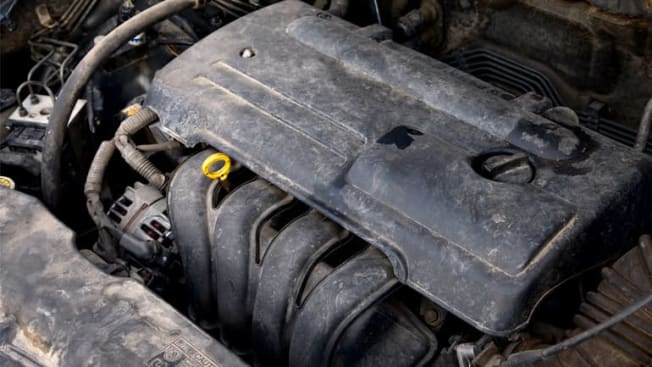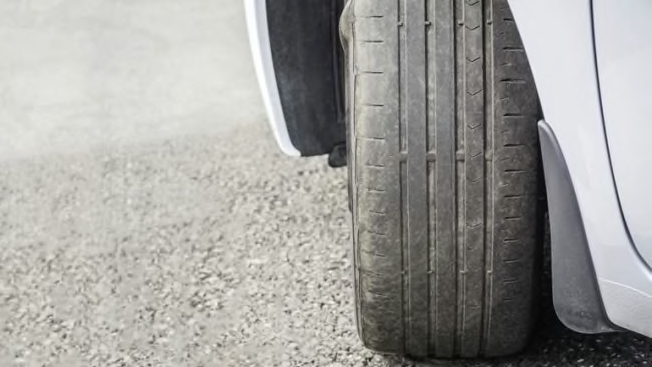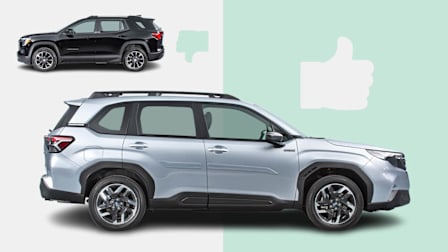How to Avoid Buying a Lemon When Shopping for a Used Car, SUV, or Truck
Our expert tips will help you steer clear of a vehicle with hidden problems

Finding a trouble-free used car has little to do with luck and everything to do with applying good research and investigative skills.
A reliable vehicle needs to be properly maintained. A vehicle with hidden damage can affect its performance, safety, or reliability.
- Avoid Buying a Lemon: Check the Reliability Record Read the Window Sticker Check the Exterior Check the Interior Check Under the Hood Check the Steering Check the Suspension Check the Tires Check the Tailpipe Step on the Gas Check for Recalls and TSBs Check the Vehicle's History Go to a Mechanic Know Your Rights
That’s why it’s important to thoroughly check out any vehicle you’re considering buying, especially now when good used cars are so hard to find.
Knowing how to spot potential problems and determining how reliable a used vehicle is can save you from expensive automotive setbacks down the road. The following advice can help you determine whether a used vehicle is a good value or could end up being troublesome.
Check the Reliability Record
A good way to reduce the risk of purchasing a trouble-prone vehicle is to select models with a good reliability record before you begin shopping.
Consumer Reports’ annual member survey provides exclusive real-world reliability information that can help you narrow your selections. For a quick reference list, see the best and worst used cars.
You can also read the reliability history charts that accompany most of Consumer Reports’ vehicle profiles to get a more detailed view of how specific models have held up in 17 trouble areas and overall.
Read the Window Sticker
The Federal Trade Commission requires dealers to post a Buyer’s Guide on every used vehicle offered for sale.
Check the Exterior
Begin by walking around the car, looking for dents, chipped paint, mismatched body panels or parts, broken lamp housings, and chipped windows. Gaps between body panels should be consistent in width and line up.
A closer inspection can reveal paint overspray on chrome or rubber trim or in the vehicle’s wheel wells. This is a telltale sign of body-panel repair.
Test for the presence of body filler with a small magnet; if it doesn’t stick to the panel, the car may have filler under the paint. (But some vehicles with plastic or fiberglass panels won’t attract a magnet at all.) A door, hood, or trunk that doesn’t close and seal properly is evidence of previous damage and/or sloppy repair work.
A sticker from the Certified Automotive Parts Association (CAPA) on a body panel means the part has been replaced. Inconsistent welds around the hood, doors, or trunk also indicate repair.
Check the Interior
A close inspection of the cabin can reveal many obvious problems, such as a sagging headliner, a cracked dashboard, and missing knobs, handles, and buttons.
Frayed seat belts or ones with melted fibers (because of friction) may be evidence of a previous frontal impact above 15 mph. Damaged safety belts should always be replaced.
Prematurely worn pedals or a sagging driver’s seat are signs that the vehicle has very high mileage. An airbag warning light that stays lit may indicate that a bag has deployed and been improperly replaced, or not replaced at all.
A mildew smell caused by a water leak can be very hard to get rid of. Discolored carpeting, silt in the trunk, or intermittent electrical problems may be signs of flood damage.
Check Under the Hood
At first glance, the engine, radiator, and battery should be relatively grease-free and have very little corrosion or none at all. Belts and hoses should be pliable and unworn. Look for wet spots, which can indicate leaking oil or fluids. Melted wires, tubes, or lines, or a blackened firewall, may be signs of overheating or even an engine fire.
When the engine has cooled, make sure that all fluids are clean, filled to the proper level, and don’t leak. Also, check the engine oil while the engine is cool. Remove the dipstick from its tube, clean it with a dry rag, reinsert it, and remove it again. The oil level should be between the “full” and “add” marks.

Photo: iStock Photo: iStock
Normal engine oil is brown or black, depending on when it was last changed. Gritty or gelatinous oil may indicate long stretches between oil changes. Thin, frothy oil that’s the color of chocolate milk may point to a blown head gasket or to a severely damaged block or cylinder head. Fine metal particles in the oil indicate internal damage or heavy wear.
The transmission fluid dipstick is usually in the rear of the engine compartment. Check it right after the car has been driven for more than 10 minutes. With the engine at idle and both the brake and parking brake applied, shift through all the gears. Leave the engine running and put it in Neutral or Park (according to the owner’s manual) and check the level in relation to the dipstick marks.
Make sure to inspect the fluid’s condition. Transmission fluid should be bright red to light reddish brown, not dark brown, black, or mustard colored; those colors can indicate serious problems. If it has a strong burned smell, that can indicate severe wear.
Check the Steering
With the car idling, turn the steering wheel right and left. Check that there isn’t any slack, “play,” or clunking noise in the steering. Excess play may indicate worn steering gear or damaged linkage.
While driving at normal speeds on smooth, flat pavement, the car shouldn’t wander or need constant steering corrections. A shaking steering wheel often indicates a need for wheel balancing or front-end alignment, which is easily remedied. But this may also be a clue that there’s a problem with the driveline, suspension, or frame, which could mean expensive repairs are in order.
Check the Suspension
Push down hard on each fender and let go. The car should rebound softly once or twice. More than two severe rebounds indicate worn shock absorbers or struts.
Also, drive the car over a bumpy road at about 30 mph. A car that bounces and slams at moderate speeds over common pavement may have a worn or damaged suspension.
Check the Tires
Wear should be even across the width of the tread and the same on the left and right sides of the car. Tires that are overinflated tend to have more wear in the middle; tires driven while underinflated tend to wear more on the sides.
Heavy wear on the outside shoulder near the sidewall of a tire indicates a car that has been driven hard. This can be a sign that other parts of the car may suffer from excessive wear due to aggressive driving. Cupped tires, those that have worn unevenly along the tread’s circumference, can indicate various problems with the steering, suspension, or brakes.

Photo: iStock Photo: iStock
Check the Tailpipe
A puff of white smoke upon startup is probably the result of condensation and not a cause for alarm. But black smoke after the car has warmed up indicates an overly rich air-fuel mixture, usually due to a dirty air filter, a faulty oxygen sensor, or a defective mass-air meter (which measures the amount of intake air).
Blue smoke indicates oil burning, a bad sign that means an expensive repair. Billowing white smoke indicates water in the combustion chamber, usually because of a blown head gasket, a damaged cylinder head, or even a cracked block, which can also be expensive to repair.
Step on the Gas
Does the engine rev excessively before the car accelerates while driving? This is a common sign of a misadjusted or worn-out clutch pedal or a defective automatic transmission.
A clutch pedal adjustment is a relatively inexpensive service compared with the high expense of fixing a damaged clutch or repairing the automatic transmission.
Listen for knocks and pings while accelerating. These indicate bad ignition timing or an engine beginning to overheat.
Check for Recalls and TSBs
Check to see if any recalls were issued and if recall service was performed. The National Highway Traffic Safety Administration lists all official recalls (nhtsa.gov/recalls; 800-424-9393).
Ask the seller for documentation on the recall service. If any recall work hasn’t been performed on a car that you’re considering, it should be done as soon as possible. Automakers are required to do recall service free of charge, regardless of the vehicle’s age or how long ago the recall was issued.
There can be delays in doing the work due to parts availability, such as with the large Takata airbag recall. That might give you pause when considering a specific model to purchase.
Technical Service Bulletins, or TSBs, are reports a manufacturer sends to its dealers about common or recurring problems with a specific model, and how to fix them. Because TSBs aren’t typically safety-related, manufacturers aren’t obligated to notify owners or pay for the repairs, though an automaker may pay for some or all of the work if an owner asks. See NHTSA’s lists of TSBs.
Check for any TSBs issued for the model you’re buying and whether the seller has had the repairs done.
Check the Vehicle's History
A vehicle history report from CarFax or Experian Automotive can alert you to possible odometer fraud; reveal past fire, flood, and accident damage; and tell you if a rebuilt or salvage title has ever been issued for the vehicle.
But these reports aren’t perfect. In fact, we’ve found vehicles with clean reports that have had notable damage. To access this information, give the service the vehicle’s identification number (VIN), which is on the top of the dashboard, near the driver’s-side roof pillar.
Some used-car stores and online marketplaces can provide history reports for free, but otherwise, there’s a significant cost. Another resource is the National Motor Vehicle Title Information System, available at vehiclehistory.gov.
A vehicle history report is a useful aid, but the best protection is having the vehicle inspected by a professional mechanic.
Go to a Mechanic
Before you buy a used vehicle, have it inspected by a qualified mechanic who routinely does automotive diagnostic work. A thorough diagnosis should cost around $120.
An organization called the Car Care Council certifies diagnostic shops. If you’re an AAA member, you can use one of the organization’s recommended facilities.
In addition to the basic diagnostic, ask the mechanic to put the vehicle on a lift and inspect the undercarriage. Kinked structural components and large dents in the floor pan or fuel tank can indicate a past accident. Welding on the frame indicates a damaged section might have been replaced or cut out during repairs, and fresh undercoating could be hiding recent structural repairs.
A dealer should have no problem lending you the car to have it inspected as long as you leave your identification. A private seller may be more reluctant, however. You may have to offer to follow the seller to the shop where the inspection will take place.
Know Your Consumer Rights
The law can protect you if your carriage turns into a pumpkin. Part of buying smart is knowing what protection you have before you need it.
State laws vary greatly in the degree of consumer protection they afford. In New York, for example, the law requires that car dealers offer written warranties on all used vehicles with less than 100,000 miles selling for $1,500 or more.
In California, it’s illegal for a dealer to sell a car with unsafe tires, damaged glass, nonfunctioning lights, or ineffective brakes. Check with your state attorney general’s office or local consumer protection agency to learn about the laws in your area.
If You’ve Bought a Lemon From a Dealer
The state attorney general’s office can say how your state laws protect you. If you suspect that you’ve bought a rebuilt wreck, contact the National Association of Consumer Advocates, which maintains a list of attorneys who specialize in such cases.
If you have a problem with a car covered by a warranty or service contract and the dealership refuses service, you have several options. For service agreements administered by an automaker, contact the company’s local representative. They’re authorized to adjust and approve repairs independently of the dealership that sold the car.
If you bought the vehicle from a franchised dealer, you may be eligible for mediation through the National Automotive Dealers Association’s Automotive Consumer Action Program. For more information, call NADA at 800-252-6232 or go to nada.org.
If the dealer is willing, consider using a dispute resolution organization to mediate your disagreement. Some service agreements require this as a first step before suing the dealer or manufacturer. Pay attention to the wording of the sales contract before buying to determine if you can sue or if you must submit to arbitration.
If You’ve Bought a Lemon From a Private Seller
Your options are much more limited. If the seller has made any written guarantees about the condition of the vehicle, you can use them as the basis for filing a lawsuit.
You can resolve disputes involving smaller amounts of money (usually less than $2,000) without an attorney through small-claims court. The clerk there can tell you what the exact dollar limit is in your state and provide information on how to file suit.




















